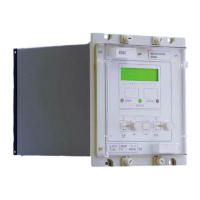VCG202/EN M/H11
Technical
8.3.3 Auxiliary voltage
The burden on the auxiliary supply depends upon the number of output relays and control
inputs energised.
DC supply 2.5 – 6.0W at Vx max with no output relays or logic inputs energized
4.0 – 8.0W at Vx max with 2 output relays & 2 logic inputs energized
5.5 – 12W at Vx max with all output relays & logic inputs energized
AC supply 6.0 – 12VA at Vx max with no output relays or logic inputs energized
6.0 – 14VA at Vx max with 2 output relays & 2 logic inputs energized
13 – 23VA at Vx max with all output relays & logic inputs energized
8.3.4 Opto-isolated inputs
DC supply 0.25W per input (50V 10ký)
8.4 Control function setting ranges
Setting Symbols Setting range Step size
Regulated voltage Vs 90 – 139V 0.1V
Deadband dVs ±0.5 % to ±20 % of Vs 0.1%
Resistive line drop compensation Vr 0 – 50V 1.0V
Reactive line drop compensation Vxl –50 – +50V 1.0V
Circulating current compensation Vc 0 – 50V 1.0V
Load shedding/boosting 0 – ±10 % of Vs 1%
Total taps available TapsAvail 1 – 30 1
Maximum tap position TP> 1 – 40/ 1 – 30 1
Minimum tap position TP< 1 – 30/ 1 – 30 1
Total number of tap changes TotalOps> 1 – 10000 1
Tap changer operations Ops/tP> 1 – 100 1
Time period tP 0 – 24 hrs 1 hr
Intertap delay tINTER 0 – 120 seconds 0.1s
Tap pulse duration tPULSE 0.5 – 5 seconds 0.5s
Tap change indication time tTapChange 1 – 3 seconds 0.1s
8.5 Time delay setting ranges
8.5.1 Inverse time delay
The general expression for the inverse time curve:
t = k + [ (initial time delay setting) x ( 1/N ) ]
where k = 0.5 for initial time delay setting
-20s
=
0 for initial time delay setting >20s
N indicates % deviation from Vs in multiples of Vdb% and is calculated as:
N =
{Vreg - Vs}
Vs
* 100
dVs
where Vreg = Voltage to be regulated (90 to 139V in step 0.1V)
Vs = Voltage setting
dVs = Dead band ((0.5% to (20% of Vs in step 0.1%)

